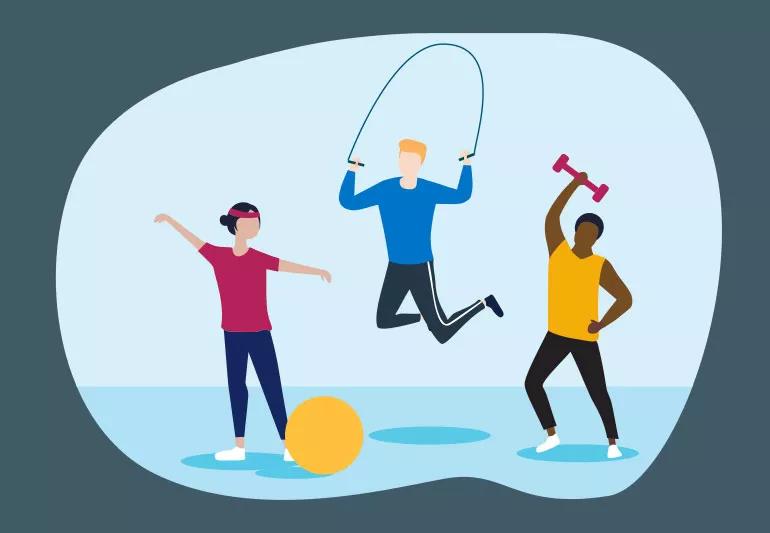Don’t buy in that exercising needs to cost a lot

If you want to get in shape but don’t want to break the bank, never fear. You don’t have to invest in a costly gym membership. You don’t need to buy the latest bike, wall technology, high-tech treadmill or elliptical machine for your home. You just need some ideas — and motivation.
Advertisement
Cleveland Clinic is a non-profit academic medical center. Advertising on our site helps support our mission. We do not endorse non-Cleveland Clinic products or services. Policy
Exercise physiologist Christopher Travers, MS, suggests six ways to exercise that won’t strain your budget. If your doctor says you’re healthy enough for exercise, there’s no better time than now.
Walking for 30 minutes a day can help you lose weight, control your blood sugar, and lower your cholesterol and blood pressure, and reduce stress. Can’t do 30 minutes? Three 10-minute walks per day work just as well.
Cost: Invest in good walking shoes, which range from $60 to $120 at sporting goods stores and online. Running shoes work, too, but can be more expensive. Good shoes will serve you well, but be sure to replace them every 400 miles or twice a year, whichever comes first.
Suspension trainers provide an inexpensive, complete full-body workout and use minimal space. Most trainer’s kit comes with a set of bands along with foot anchors and handles to accommodate different exercises. These resistance exercises help you develop flexibility, balance, strength, and joint stability all at the same time. Anyone can use TRX systems.
Cost: A typical suspension training system can cost anywhere from about $40 and up, depending on how big of a system you want to build. But you can bring them with you anywhere so you don’t have to invest in the cost of a gym membership. That means you get your money’s worth after a couple of months of use.
Advertisement
Using an exercise ball will help you keep your abdominal muscles, back and hips strong. It can also help you improve your balance and agility. Use the exercise ball for stretching after workouts, too. You can find good exercise ball routines online.
Cost: Exercise balls come in different weights and materials and run from about $8 to $50. Printing out an online exercise ball routine will just cost you printer ink and paper.
Dumbbells and kettlebells can help you gain strength or maintain it. Start with the weight range that works best for you without straining too much. When you feel ready, increase the load or workout time. Be careful, though — using weights incorrectly can lead to injury. Use your weights in front of a mirror to check your posture. If you have questions, consult an exercise expert.
Cost: Depending on their weight and design, dumbbells and kettlebells range from $10 to $75 in stores.
Forget past memories of gym class and focus on how well you’ll tone your body with push-ups, crunches, squats, lunges and leg lifts.
Cost: This is the least expensive way to exercise. All you need are comfy workout clothes. You can lie on a clean towel or purchase a yoga mat for as little as $7 in stores.
When it comes to video workouts, there’s something for everyone. Pilates, yoga, kickboxing and even dance. A good combination of repetition and variety is always key when it comes to sticking to a good program. Try different options and vary them to keep yourself interested.
Cost: There are so many free options when it comes to online videos that keep you in shape — and more and more online workout classes are populating your favorite sites by the day. Choose what you like then tag and save a collection. Reuse every day.
“Most exercises are easily accessible and affordable, and you can do many of them right from your own home,” Travers says. “If you’re really planning on staying home to workout, you can even have inexpensive mats or workout gear or equipment shipped directly to your house. It really doesn’t matter where you exercise or how… just as long as you do it — and do it often.”
Advertisement
Learn more about our editorial process.
Advertisement

The exercise — which you’ve probably been doing since grade school — can be intimidating, but proper form can help

Exercise lowers risk for heart conditions, improves mental health and reduces visceral fat that can compromise your organs

Ask questions, get referrals and consider if someone is a good fit for you and your fitness goals

Expect a few bumps in the road, work out for the right reasons and give yourself some credit

Jump into the swing of things to improve your coordination, burn calories and get your heart rate going

Walking with a weighted backpack is a low-impact, full-body workout that’s growing in popularity

A super high heart rate means you’re burning more than fat

Meet your workout goals by accounting for frequency, intensity, time and type

Type 2 diabetes isn’t inevitable with these dietary changes

Applying a hot or cold compress can help with pain